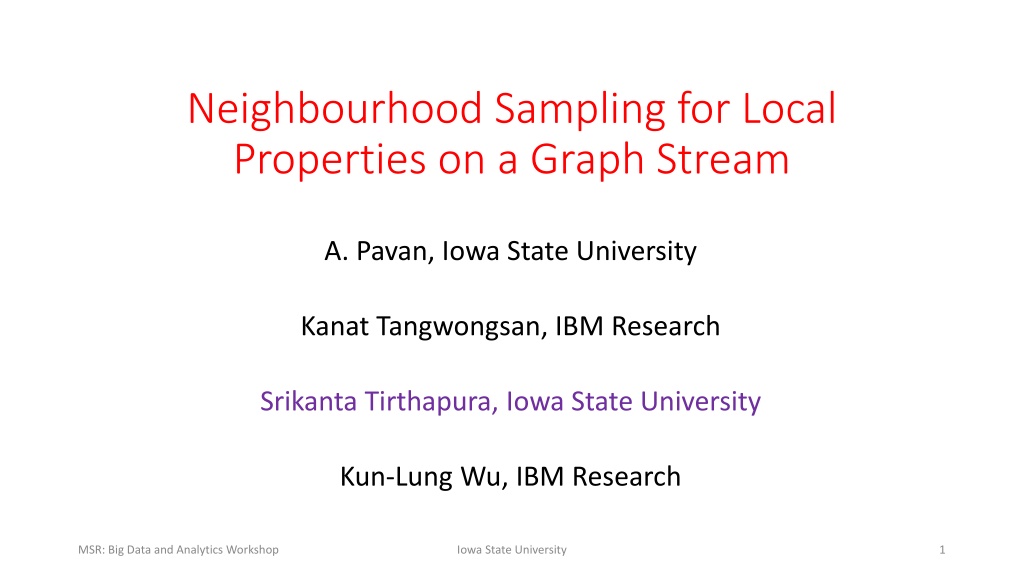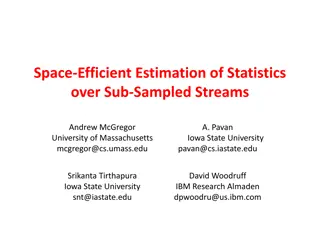Neighbourhood Sampling for Local Properties on Graph Streams
The research explores neighbourhood sampling for local properties on graph streams, focusing on counting subgraphs within 1-neighbourhood of a vertex. It addresses the Triangle Counting Problem and explains the significance of counting triangles in various contexts such as social network analysis and web spam detection. The algorithm discussed can be deployed on a single machine efficiently for processing large graphs. Additionally, the contributions of neighbourhood sampling in applications like counting and sampling triangles in a graph are highlighted.
Download Presentation

Please find below an Image/Link to download the presentation.
The content on the website is provided AS IS for your information and personal use only. It may not be sold, licensed, or shared on other websites without obtaining consent from the author. Download presentation by click this link. If you encounter any issues during the download, it is possible that the publisher has removed the file from their server.
E N D
Presentation Transcript
Neighbourhood Sampling for Local Properties on a Graph Stream A. Pavan, Iowa State University Kanat Tangwongsan, IBM Research Srikanta Tirthapura, Iowa State University Kun-Lung Wu, IBM Research MSR: Big Data and Analytics Workshop Iowa State University 1
Graph Streams Example: Network Monitoring IP addresses are vertices of a graph Edges represent connections between vertices Edges of the Graph Arrive in Sequence Continuously Maintain a Property of the Evolving Graph Local Property: Count subgraphs within 1-neighbourhood of a vertex MSR: Big Data and Analytics Workshop Iowa State University 2
Big Data, Small Machines Algorithm can be deployed on a single machine, reasonable resources Single Pass Through Data Online arrivals Also suitable for disk-resident data Effective use of a multicore machine Ex: process a 167GB graph in 1000 seconds, on 12 core machine MSR: Big Data and Analytics Workshop Iowa State University 3
Problem: Triangle Counting Problem: Count the number of triangles in a simple undirected graph MSR: Big Data and Analytics Workshop Iowa State University 4
Why Triangle Counting (1) Number of triangles is a basic structural property Social Network Analysis: Transitivity Coefficient = 3 * # Triangles / # connected triples Related Clustering Coefficient Measure how dense the graph is MSR: Big Data and Analytics Workshop Iowa State University 5
Why Triangle Counting (2) Web Spam Detection (Becchetti et al. 2008) A higher-than usual number of triangles is an indicator of web spam Biological Networks (Przulj et al. 2006, Kashtan et al. 2002) Generalizations of Triangle Count used in Graphlets and Network Motifs Structural Summary of a Graph = vector, containing the number of occurrences of various subgraphs MSR: Big Data and Analytics Workshop Iowa State University 6
Contributions Neighborhood Sampling: Simple random sampling method for graph streams Applications: Counting and Sampling Triangles in a Graph Counting Higher order cliques K4, K5, etc Directed Cycles in directed graphs Experiments showing this is a practical method MSR: Big Data and Analytics Workshop Iowa State University 7
Prior Work Streaming Triangle Counting Bar-Yossef, Kumar, Sivakumar (2003): Reductions to frequency moments of appropriately defined streams Jowhari and Ghodsi (2005): Sampling-based and Sketch-based estimators Buriol et al. (2006): Another Sampling-based Estimator Ahn, Guha, McGregor (2012): Sketch-based, insertions and deletions Kane et al. (2012), Manjunath et al. (2011): sketch-based, more general subgraphs Seshadri, Pinar, Kolda (2012) Batch (non-streaming) Triangle Counting Pagh and Tsourakakis (2012) Suri and Vassilvitskii (2011) MSR: Big Data and Analytics Workshop Iowa State University 8
Graph Model Simple Undirected Graph (extends to directed graphs easily) n vertices, m edges Problem: Estimate (G) = number of triangles in G Adjacency Stream Model: Edges arrive in an arbitrary order Incidence Stream Model: all edges incident to a vertex arrive together MSR: Big Data and Analytics Workshop Iowa State University 9
Sampling and Counting Suppose a procedure A that on graph G: If succeeded , then return a triangle from G, chosen uniformly at random Else, return failure Procedure A can be used in triangle counting Probability of A succeeding proportional to # triangles Repeat Procedure A many times, use fraction of successes Accuracy of Estimate depends on the probability that A fails MSR: Big Data and Analytics Workshop Iowa State University 10
Example Triangle Sampling Procedures Algorithm I: Sample a triple (u,v,w) in graph uniformly from all ? See if (u,v,w) form a triangle 3 possible triples Algorithm II: (Buriol et al., 2006): Sample an edge (u,v) in graph Sample a random vertex w, other than u and v See if (u,v,w) form a triangle MSR: Big Data and Analytics Workshop Iowa State University 11
Neighborhood Sampling Idea Two edges are adjacent if they share a vertex Choose a random edge r1 in the graph Choose a random edge r2, that appears after r1, and is adjacent to r1 See if triangle defined by r1, r2 is completed by a third edge Above procedure can be done in a constant number of words in a streaming manner. MSR: Big Data and Analytics Workshop Iowa State University 12
Sampling Bias e7 e8 e9 e11 e4 e3 e1 e10 e6 e5 e2 MSR: Big Data and Analytics Workshop Iowa State University 13
Sampling Bias Pr[e1,e2,e3]=Pr[r1=e1].Pr[r2=e2|r1=e1] =(1/10)*(1/2)=(1/20) e7 e8 e9 e11 e4 e3 e1 e10 e6 e5 e2 MSR: Big Data and Analytics Workshop Iowa State University 14
Sampling Bias Pr[e1,e2,e3]=Pr[r1=e1].Pr[r2=e2|r1=e1] =(1/10)*(1/2)=(1/20) e7 e8 e9 e11 e4 e3 e1 Pr[e4,e5,e6]=Pr[r1=e4].Pr[r2=e5|r1=e4] =(1/10)*(1/7)=(1/70) e10 e6 e5 e2 MSR: Big Data and Analytics Workshop Iowa State University 15
Sampling Bias Pr[e1,e2,e3]=Pr[r1=e1].Pr[r2=e2|r1=e1] =(1/10)*(1/2)=(1/20) e7 e8 e9 e11 e4 e3 e1 Pr[e4,e5,e6]=Pr[r1=e4].Pr[r2=e5|r1=e4] =(1/10)*(1/7)=(1/70) e10 e6 e5 e2 For edge e, define c(e) = Number of edges adjacent to e, and that follow e MSR: Big Data and Analytics Workshop Iowa State University 16
Sampling Bias Pr[e1,e2,e3]=Pr[r1=e1].Pr[r2=e2|r1=e1] =(1/10)*(1/2)=(1/20) e7 e8 c(e1) = 2 e9 e11 e4 e3 e1 Pr[e4,e5,e6]=Pr[r1=e4].Pr[r2=e5|r1=e4] =(1/10)*(1/7)=(1/70) e10 e6 e5 e2 c(e4) = 7 For edge e, define c(e) = Number of edges adjacent to e, and that follow e MSR: Big Data and Analytics Workshop Iowa State University 17
Sampling Bias e7 e8 Pr[Triangle T, where e is the first edge] =1 c(e) e9 e11 e4 e3 e1 m 1 e10 e6 e5 e2 MSR: Big Data and Analytics Workshop Iowa State University 18
Handling Sampling Bias For sampling a triangle uniformly at random Use neighbourhood sampling Compute (online) the bias in sampling a triangle Reject the sample, probability proportional to bias For counting triangles Use neighbourhood sampling as described Compute (online) the bias in sampling a triangle Incorporate bias directly into estimator MSR: Big Data and Analytics Workshop Iowa State University 19
Counting Triangles in a Graph 1. Let r1 be a random edge in the edge stream 2. Let E1 = all edges that arrived after r1, and adjacent to r1 A. Let r2 = random edge from E1 B. Let c1 = size of E1 3. If the triangle defined by {r1, r2} is completed: A. Return (?1?), where m is the number of edges B. Return 0 otherwise MSR: Big Data and Analytics Workshop Iowa State University 20
Estimator Properties Let X be the return value of the algorithm E[X] = # triangles in G Take mean of O((# edges) * (max degree) / (# triangles)) estimators to get a good approximation MSR: Big Data and Analytics Workshop Iowa State University 21
Time Complexity Running r estimators in parallel means O(r) time per update? Bulk Processing, process w edges at a time: For each estimator, first level random sample updated in O(1) time Second level update is more complex, two passes through the batch Using a batch size w = O(r), entire batch of w edges can be processed in O(w) time, yielding an amortized processing time of O(1) per edge MSR: Big Data and Analytics Workshop Iowa State University 22
Counting and Sampling 4-Cliques 1. Choose a random edge r1 in the graph 2. Choose a random edge r2, that appears after r1, and is adjacent to r1 3. Choose a random adjacent edge r3, which appears after {r1,r2} and has one endpoint in common with {r1,r2} 1. Any edge with both endpoints in {r1,r2} is surely retained 4. Wait for 4-clique defined by {r1,r2,r3} to be completed But this misses out cliques whose first two edges are not adjacent to each other another case to handle such cliques. MSR: Big Data and Analytics Workshop Iowa State University 23
Extensions Transitivity Coefficient of a Graph = 3 * # triangles / # connected triples Sliding Windows Directed 3-cycles in a directed graph Counting patterns that have temporal constraints: how many instances where A B, followed by B C, followed by C A? MSR: Big Data and Analytics Workshop Iowa State University 24
(Preliminary) Experimental Results Orkut Graph 3 million vertices 117 million edges max degree = 67,000 Number of triangles = 633 million # Estimators 1 K 128 K 1 M Relative Error 4.6 % 2.13 % 1.48 % Time Taken 52 sec 75 sec 103 sec (33 IO) MSR: Big Data and Analytics Workshop Iowa State University 25
Runtime versus number of estimators Livejournal graph 4 M vertices 35 M edges 30 K max degree 178 M triangles Youtube graph 1 M vertices 3 M edges 57 K max degree 3 M triangles MSR: Big Data and Analytics Workshop Iowa State University 26
Relative Error versus Number of Estimators Livejournal graph 4 M vertices 35 M edges 30 K max degree 178 M triangles Youtube graph 1 M vertices 3 M edges 57 K max degree 3 M triangles MSR: Big Data and Analytics Workshop Iowa State University 27
Conclusions General Sampling Method for Estimating Cardinality of Graph Patterns Small sized cliques Extendible for special cases ex: temporal constraints, edge directions Sticky sampling for graph streams Technique: Sample within neighbourhood of current edges Compute the bias online Incorporate the bias into the estimator Fast Implementations Multicore Machine: Synthetic Graph of size 167GB in 1000 sec on a 12 core machine MSR: Big Data and Analytics Workshop Iowa State University 28
Thank you Reference: Counting and Sampling Triangles from a Graph Stream Research Report RC25339, IBM http://domino.research.ibm.com/library/cyberdig.nsf/papers/A9F1472 6B795E13185257AEE0058FCD3 http://www.ece.iastate.edu/~snt/ MSR: Big Data and Analytics Workshop Iowa State University 29























